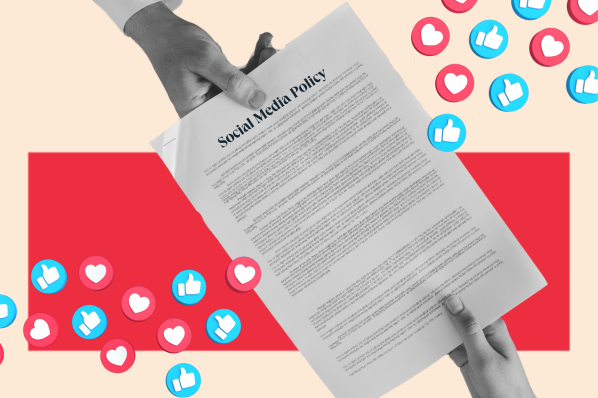Social media matters for brand success. But it’s not enough to simply have a social presence; instead, businesses need social media marketing goals that help them attain specific outcomes in the short-term and keep users engaged over time.
Statistics tell the tale of social impact: 77 percent of social media marketers say that their efforts have been somewhat to very effective in 2022, 79 percent of companies are buying ad space on Facebook and the same number plan to keep investing in Twitter Spaces.
Download your free marketing goal-setting template here.
Ready to take your social media marketing to the next level? Here are nine goals to help your brand get noticed.

Free SMART Goal Template
A free template to help you create S.M.A.R.T. goals for marketing campaign success.
- Set your goals
- Calculate your metrics
- Evaluate your success
Download Free
All fields are required.

Social Media Marketing Goals for 2022
While you don’t need to meet every social media marketing goal listed to succeed, these objectives offer a solid starting point for a measurable marketing increase.
Goal 1: Increasing brand awareness
Goal 2: Driving website traffic
Goal 3 Getting more leads
Goal 4: Boosting user engagement
Goal 5: Improving customer service
Goal 6: Enhancing brand reputation
Goal 7: Creating more conversations
Goal 8: Understanding your customers
Goal 9: Tracking your mentions
Goal 1: Increasing Brand Awareness
Increasing brand awareness is all about getting the message out to potential customers. In practice, this means more than just posting content to social media — it’s about posting content to social media sites where it will be seen by your target audience.
Potential KPIs and metrics:
- Total number of social channel followers
- How many users are interacting with your content daily/weekly/monthly
- Volume of shares, mentions, and retweets
Goal 2: Driving Website Traffic
Getting more traffic to your website from social media sources can help boost lead generation and sales conversion. Here, social analytics tools are useful for measuring key social metrics and how many unique visitors are viewing your site.
Potential KPIs and metrics:
- Number of visitors referred from social media sites
- Percentage of overall traffic from social media
- Bounce rate of social traffic (how many users visit but don’t stay)
Goal 3: Getting More Leads
More leads mean more opportunities for sales. And while getting leads is typically part of the larger sales funnel process, social media offers a way to start collecting basic lead information.
Potential KPIs and metrics:
- Contact information such as email addresses provided by customers
- Downloads of content assets from social media links
- Participation in social media events such as polls or contests
Goal 4: Boosting User Engagement
User engagement with your social posts is measured by actions such as comments, likes, and shares, and helps give a sense of how well your social media marketing is working to drive user interest.
Potential KPIs and metrics:
- Post engagement rate — how many users interact with a post
- Share rate — how many users choose to share your content
- Time-based engagement — how many users share your content over a specific time period
Goal 5: Improving Customer Service
Customers come for the product or service but stay for your customer service. As a result, it’s worth evaluating your ability to ensure customer satisfaction via social channels.
Potential KPIs and metrics:
- How quickly you respond to customer messages
- The number of complaints or concerns received via social media
- Overall satisfaction with your service, often measured using an email or social survey
Goal 6: Enhancing Brand Reputation
If customers don’t trust your brand, they won’t buy what you’re selling. And social media makes it easier than ever for customers to share exactly what they’re thinking — good or bad — about your brand, making effective reputation management critical.
Potential KPIs and metrics:
- Mentions — how often is your brand mentioned in any social media posts?
- Hashtags — what are people saying about your brand with relevant hashtags related to your product or service?
- Sentiment — what is the overall user sentiment toward your brand? Good? Bad? Impartial?
Goal 7: Creating More Conversations
Social media is, well — social. This means it’s a place for conversation and interaction, and if your brand can get in on the action, so much the better for your sales.
Potential KPIs and metrics:
- Number of users making posts on your Facebook page or in your Twitter chats
- Number of daily active users on platforms such as Slack
- Number of reviews for your products or services on social platforms
Goal 8: Understanding Your Customers
The more you know about your customers, the better. By understanding what they’re looking for, what they want to avoid, and how they want brands to treat them, your team can better tailor marketing and sales messages to your target audience.
Potential KPIs and metrics:
- The kinds of posts do your customers comment on
- Their most common pain points (from mentions and hashtags)
- Their expectations in terms of brand response time and marketing content
Goal 9: Tracking Your Mentions
This goal expands mention monitoring from customers to the press: Where is your brand getting noticed by industry publications or thought leaders (or is it getting mentioned at all?)
Potential KPIs and metrics:
- The number of users who saw your PR campaign
- Questions about your product or service from industry leaders or journals
- Coverage from social media influencers
Social Media SMART Goals
It’s always good to be smart, but when it comes to social media it’s even better to be SMART.
Jokes aside, SMART is a goal-setting acronym that makes it easier to meet intended targets. SMART stands for:
S — Specific
M — Measurable
A — Attainable
R — Relevant
T — Time-bound
If your goals meet SMART criteria, you’re more likely to see success. And when it comes to social media, SMART goals are essential to help brands master this medium.
Why? Because social media is constantly changing. From what consumers want to how they interact with brands to what they’re saying online, social media is never static. SMART goals give companies the ability to better manage the ever-evolving nature of social media discourse and the interaction between marketing impressions and overall reach.
If you’re feeling overwhelmed, don’t worry: We’ve got you covered with our SMART marketing goals template. Get it here.
Social Media SMART Goals Examples
Now, let’s take each of our nine social media marketing goals above and apply the SMART framework.
SMART Goal 1: Increasing Brand Awareness
Specific: We want to increase brand awareness by creating and posting new content twice per week.
Measurable: Our goal is a 5% increase in our total number of social media followers.
Attainable: Our followers increased by 2% last month when we began posting content more frequently.
Relevant: Increasing brand awareness will help drive more interest in our products and services.
Time-bound: One month.

Free SMART Goal Template
A free template to help you create S.M.A.R.T. goals for marketing campaign success.
- Set your goals
- Calculate your metrics
- Evaluate your success
Download Free
All fields are required.

SMART Goal 2: Driving Website Traffic
Specific: We want to drive more traffic to our website by increasing the number of referrals from social media sites.
Measurable: Our goal is a 10% increase in traffic from social media sites.
Attainable: Targeted content publishing last month saw a 3% increase in traffic from social sites.
Relevant: More website traffic means more users browsing our products and services.
Time-bound: Six months.
SMART Goal 3: Getting More Leads
Specific: We want to get more leads from social media sites by creating content that encourages users to share their contact information.
Measurable: Our goal is to generate 10 new leads per week.
Attainable: Previous efforts at engaging content have increased the total number of users subscribed to our newsletter.
Relevant: More leads means more opportunities to find prospective buyers.
Time-bound: Four weeks.
SMART Goal 4: Boosting User Engagement
Specific: We want to increase the number of users that interact with our social media posts by creating more compelling content.
Measurable: Our goal is 30 shares per week.
Attainable: Our last engagement campaign saw a measurable increase in post comments.
Relevant: Increased user engagement leads to more hashtags and mentions and in turn drives more website traffic.
Time-bound: Two months.
SMART Goal 5: Improving Customer Service
Specific: We want to improve social customer service by ensuring that customers receive timely and relevant answers to their questions.
Measurable: Our goal is to reduce customer waiting time for responses by 20%.
Attainable: Leveraging social media marketing apps helped us streamline the messaging process.
Relevant: Improved customer service means higher satisfaction and increased consumer loyalty.
Time-bound: Three weeks.
SMART Goal 6: Enhancing Brand Reputation
Specific: We want to enhance brand reputation by better understanding customer sentiment.
Measurable: Our goal is to increase positive brand mentions by 30%.
Attainable: Analysis of customer hashtags helped pinpoint key areas of frustration.
Relevant: Better brand reputation means increased customer trust and leads to more reliable conversion rates.
Time-bound: Four months.
SMART Goal 7: Creating More Conversations
Specific: We want to create more conversations by increasing our total number of followers on Facebook.
Measurable: Our goal is to boost the total number of Facebook followers by 5%.
Attainable: Efforts to engage our Twitter community resulted in a 10% boost to conversations over time.
Relevant: More conversations means more brand mentions — and potential referrals.
Time-bound: Two months.
SMART Goal 8: Understanding Your Customers
Specific: We want to gain a better understanding of customers to better align with their expectations by evaluating the types of posts they comment on.
Measurable: Our goal is to collect and analyze customer data to discover key trends.
Attainable: Evaluation of customer pain points provided insight into what they didn’t like about our social presence.
Relevant: Better knowledge of customer preferences helps tailor content to meet their needs.
Time-bound: One month.
SMART Goal 9: Tracking Your Mentions
Specific: We want to track the number of mentions by both journalists and influencers.
Measurable: Our goal is to increase the total number of press mentions by 25%.
Attainable: Previous PR efforts have led to increased press interest.
Relevant: Mentions in the press or by influencers can drive both social and website traffic.
Time-bound: During the length of the PR campaign.
Get SMART for Social Media Success
SMART social media marketing goals offer the dual benefit of short-term impact and long-term gain.
While it requires some legwork to ensure you’ve got a solid goal format, you can streamline the process with HubSpot’s SMART goal template — pair it with any of our nine social media goals to help your brand track key social metrics get noticed for all the right reasons.
Editor's Note: This article was originally published in October 2016 and has been updated for comprehensiveness.

Social Media Strategy



![The most effective types of content on social media in 2025 [new data]](https://53.fs1.hubspotusercontent-na1.net/hubfs/53/Copy%20of%20Featured%20Image%20Template%20Backgrounds%20(16).png)


-1.jpg)
.png)
![How to Create a Great Social Media Strategy in 2025 [+ New Data]](https://53.fs1.hubspotusercontent-na1.net/hubfs/53/social-media-strategy.webp)



